|
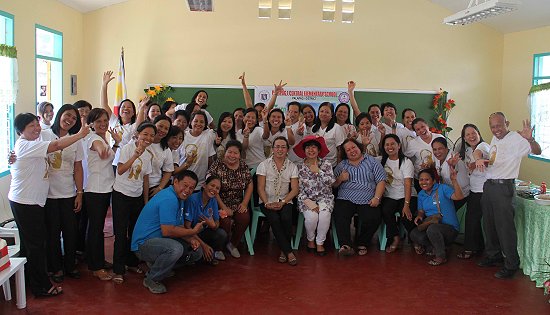
Photo
shows teachers of Palapag I Central School with PLDT Head of
Community Relations and Public Affairs Evelyn del Rosario and
Northern Samar Board Member Florencio Batula during the turnover
activity of a two-classroom building for the school. |
PLDT, PBSP bring
students closer to school with new classrooms
By PBSP
June 21, 2014
TACLOBAN CITY – To
support the Department of Education’s (DepEd) aim to bring more
students to school this coming year, Philippine Long Distance
Telephone (PLDT) Company with Philippine Business for Social Progress
(PBSP) turned over three classrooms in the remote towns of Northern
Samar.
These classrooms were turned
over to Palapag I Central School (CS) of Barangay Asum in Palapag and
Barobaybay Academy Mission School (BAMS) in Barangay Barobaybay of
Lavezares in a two-day activity attended by PLDT Head of Community
Relations and Public Affairs Evelyn del Rosario and PBSP Senior
Relationship Management Officer Olive Jabido.
Aside from the classrooms,
PLDT also committed to fund for the construction of a computer
laboratory in Palapag I CS.
These projects are funded
through the Motolite-PBSP Balik-Baterya Program, where companies are
encouraged to donate their used lead acid batteries (ULABs) which are
then bought and recycled by Motolite. The sales of the donations are
used to fund several projects implemented by PBSP.
PLDT Head of Community
Relations and Public Affairs Evelyn del Rosario shared that the
company has been funding projects for education since it is closest to PLDT and PBSP Chairman Manuel Pangilinan’s heart.
“MVP is the key to all these
projects. And in PLDT, we always believe that education is the
greatest equalizer. We also aim to help teachers and schools become
globally competitive,” she added.
Better Education
DepEd Northern Samar Schools
Division Superintendent Officer-in-Charge Cristito Eco stated how the
classrooms could contribute to the provinces’ achievement of their
targets given their previous year’s poor performance.
He revealed that in the
previous school year, Northern Samar only reached 96% participation
rate out of 116,000 enrollees, which left 4,640 students who had not
been going to school.
“This is a concern we have
to address this year. But with the presence of new physical facilities
like these new classrooms in our schools, I know this will encourage
those 4,000 students to study again, which will eventually improve our
performance indicators,” Eco said.
In Palapag I CS, which is
expecting more than 1,400 enrollees this school year, the classrooms
will be used by its grade 5 & 6 students who used to share classrooms
with the other lower grades.
On the other hand, the new
classroom donated to BAMS will be used as a Technology and Livelihood
Education (TLE) center for its high school students in preparation to
the K-12 curriculum. It will be the first center of its kind in
Barobaybay, with BAMS catering to scholars living in remote island
barangays.
“With the new center, we
know that our students will be more inspired to study because we are
provided with an excellent physical setting conducive for learning,”
BAMS incoming principal Sr. Ma. Rosalina Luzon said.
“With the skills that they
will learn using the classroom as a TLE center, they can always use
these skills to find a job and continue what they want for their
educational attainment later on,” PBSP’s Jabido also shared.
Balik-Baterya
Since its launching in 2006,
the Balik-Baterya Program has cinched the support of 138 donor
companies and collected more than P57 million worth of ULABs that
allowed them to implement and support 89 projects across the country.
PLDT has been a partner of
the program since 2008 and has become the program’s top donor. With
its ULABs, the company was able to provide 44 Learning Resource
Centers or mini-libraries; construct roads, drainage systems and other
facilities such as multi-purpose centers; and organize TB prevention
programs.
PLDT is also the first
company that used its ULAB donations to build classrooms and computer
laboratories with equipment. With the addition of the newly donated
classrooms, the company has already provided seven classrooms and two
computer laboratories in the Visayas.
“We are slowly addressing
the growing classroom backlog of the country so we could provide more
classrooms to students who want to go to school. Our only hope is that
the students will maximize the usage of this facility so they will
have better learning experiences,” Jabido added.
To the teachers, del Rosario
said: “You are our modern heroes, and it is through you that we are
successful in fighting illiteracy. Continue to inspire more students
to learn since it is only through education that we can be at par with
anyone.”
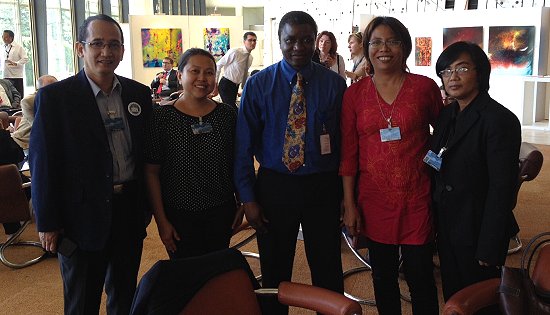
Delegation
of Ecumenical Voice for Human Rights and Peace in the
Philippines (EcuVoice) with Dr. Chaloka Beyani, UN Special
Rapporteur on the human rights of internally displaced persons. |
UN rights heads to visit PH
PH human rights
group discussed concerns with UN special rapporteurs
By KARAPATAN
June 12, 2014
GENEVA, Switzerland –
Human rights advocates of the Ecumenical Voice for Peace and Human
Rights (EcuVoice), who are participating in the 26th United Nations
Human Rights Council sessions, welcomed the information conveyed by
two United Nations special rapporteurs on their official visits to the
Philippines to conduct independent investigations on the human rights
situation in the country.
UN Special Rapporteur on the
human rights of internally displaced persons Dr. Chaloka Beyani is
slated to conduct his official visit this year, while UN Special
Rapporteur on the independence of judges and lawyers Gabriela Knaul
has recently submitted her request to visit the country.
In a meeting with the UN
mandate holders in Geneva, Switzerland, members of the EcuVoice
delegation enjoined the independent experts to look into reports of
forced evacuations due to military operations, forced evictions, the
continuing displacement of typhoon Haiyan victims, and the attacks
against human rights lawyers in the Philippines.
Representatives of EcuVoice
apprised Dr. Beyani of the forcible evacuations caused by intensified
military operations in a growing number of areas in the country,
especially in Mindanao, where 60% of Armed Forces of the Philippines
personnel are currently deployed.
"Peasant communities and
indigenous tribes are driven away from their homes by extractive
operations, tourism, and infrastructure projects such as dams. The
plight of poverty-stricken indigenous communities in Talaingod, Davao
del Norte and many other parts of Mindanao is exacerbated as big
foreign and domestic mining companies encroach on their lands and
ancestral domains," Karapatan secretary general Cristina Palabay
explained to Mr. Beyani.
Typhoon survivor Rev. Irma
Balaba said that "more than six months after super typhoon Haiyan
(Yolanda) struck the Philippines, the survivors continue to languish
in appalling conditions with scarce, if any, access to shelter,
potable water, basic services, and sustainable livelihood, despite the
outpouring of support from the international community."
Atty. Edre Olalia, secretary
general of the National Union of Peoples' Lawyers (NUPL), provided
updates for Knaul on the escalating tactics employed to jeopardize,
not just the independence of lawyers and judges, but their very lives
and personal security, particularly human rights lawyers. He pointed
out the continuing killings of lawyers and judges as well as various
attacks like labelling, surveillance, hacking of phones and emails,
and filing of nuisance charges against rights lawyers.
The present case of NUPL
officer Cathy Salucon was highlighted considering the specific and
imminent threat against her. "The human rights lawyers in the
frontline are also under attack and immediate steps must be taken by
the international community on top of domestic efforts before things
even get worse," Olalia pleaded with Knaul.
A UN mandate holder like
Special Rapporteurs can only conduct a country visit upon formal
invitation by the State on an official request. The Philippine
government previously announced during the country's Universal
Periodic Review in 2012 that it will officially invite Beyani, but the
official visit has not materialized since then. The former special
rapporteur on the independence of judges and lawyers and judges first
requested to visit the Philippines in 2006, and has since reiterated
this request. The Philippine government, however, has not issued an
invitation.
Aside from Palabay and
Olalia, the EcuVoice delegation includes Rev. Irma Balaba, assistant
programme secretary of the Christian Unity and Ecumenical Relations
programme of the National Council of Churches in the Philippines; and
Dr. Angie Gonzales, Atty. Mary Kristerie Baleva and Julie Palaganas of
the International Coalition for Human Rights in the Philippines.
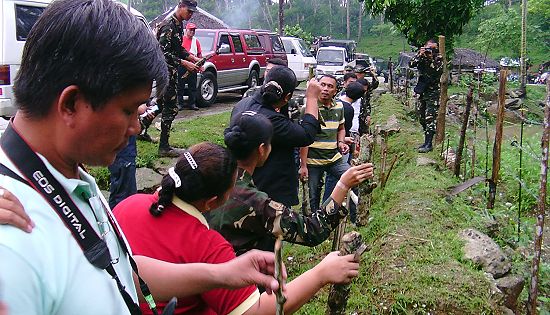
Soldiers
and local media in a tree planting activity inside the 87IB
camp. |
Greening an army
camp in Samar
By JAZMIN BONIFACIO
May 13, 2014
BRGY. POLANGI,
CalbigaSamar – Soldiers of the 87th Infantry Battalion based in
Barangay Polangi, Calbiga Samar started something they hope will last
for years to come. They planted a tree.
Army camps like in Calbiga
is different from traditional one. The soldiers demonstrated skills by
planting trees in the tree park in an effort to develop a sustainable
agriculture and agro forestry. This initiative of `trees for greener
future’ has worked well through, beautification of the barracks and
rehabilitation of the entire camp through planting indigenous trees.
This is a park within the
Army barracks, where the soldiers usually take their walk, hundreds of
army soldiers mobilized to plant trees inside barrack compound.
In coordination with the
office of Calbiga Mayor and the local office of the Department of
Environment and Natural Resources (DENR), the 87th IB is establishing
a tree park inside the army camp.
The initiative is in
accordance with President Benigno Aquino 111, Executive Order No. 26,
implementing the National Greening Program along government policy to
pursue sustainable development for poverty reduction, food security,
biodiversity conservation, and climate change mitigation and adaption.
The government’s National
Greening Program aims to plant 1.5 billion trees in 1.5 hectares of
public land within a span of six years, from 2011 to 2016.
Lt. Col. Antonio B. Dulnuan
Jr., Battalion Commander of 87th Infantry Battalion, is confident the
initiative will give a boost to the participation of the military
personnel in the greening program because of the sense of ownership
that will be developed among them as they plant trees inside the ½
hectares Tree Park in Calbiga Samar.
The 87th IB has planted 50
seedlings of Rambutan, 115 seedlings of Red Lawaan and 115 seedlings
of Mahugani.
It was learned that 87th IB
covers the municipalities of San Jose de Buan, Paranas, Jiabong,
Motiong, Daram, Hinabangan, Calbiga, Villareal, Pinabacdao, Talalora,
Sta. Rita, Basey, Zumarraga, San Sebastian and Marabut all of Samar.
Soldiers from 87th IB
encourage growing high nutrition crops and local food production.
Producing a variety of resilient food crops, helping communities to
diversify their nutritional sources, which is especially useful during
extreme weather conditions. They as well are engaging rural
communities, to help them address their needs for essential basic
services such as water, fertile soil, and a healthy ecosystem through
planting trees on critical watersheds.
Planting trees on public
lands and mountain catchments helps to reduce environmental
destruction – halting erosion through the retention of topsoil,
harvesting of rainwater, and helps communities build their resilience
to climate change.
Life of the Yolanda “no build
zone” dwellers
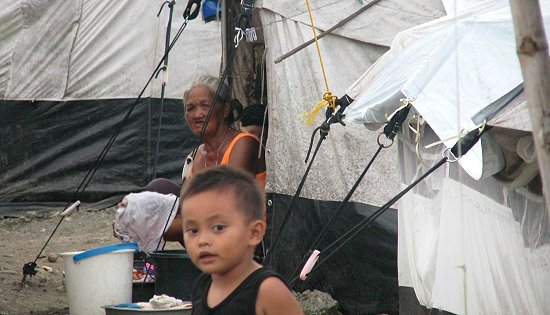
By JAZMIN BONIFACIO
April 27, 201
TACLOBAN CITY – The
devastation from the 2013 Super Typhoon Yolanda and storm surge will
not soon be forgotten. And it’s been five months now and the
devastation of typhoon Yolanda in the city of Tacloban and in the
entire Eastern Visayas region are still evident but so too are signs
of progress.
And areas in the region
worst hit by storm surge are still in the process of recovery, with
many residents continuing to live in the tents cities along the no
build zone areas.
With these, ‘shelter’ still
the hottest issue in the city and to other nearby towns severely
inflicted by huge tsunami-like surges seawater.
Respective government
agencies, international organizations and non government organizations
are doing steps to respond well to all of the possible help to be
extended.
The local government of
Tacloban is providing temporary shelter to displaced families,
especially those families living in the no build zone areas.
According to Derrick Anido,
city disaster risk reduction management chief officer, said that
rebuilding homes do take some time, more so that the local government
is fronted with problems like they don’t have enough space for the
relocation land for the relocation site.
With these, survivors living
in the coastal areas, especially, those in the `no build zone’ tried
again to live in their ruined homes. They had to reconstruct again
some shanty houses, made of tarpaulins as a roof and for others they
put some wood on the side and for sure it won’t stand up to a storm.
However, ‘waray-waray’
people (to what locals in Eastern Visayas fondly called), are known to
be resilient people and they had the ability to use the support
available to them in their environment to their advantage.
Pedro `Dodot’ Cajipe, a
father of 4 children, recalled how the water has gotten into all the
houses in Costa Brava, San Jose and how fallen trees have broken most
of the homes. Almost everything has been destroyed.
“Water has gotten into all
the houses in our village… the storm surge has taken everything we
earned, no food, no place to stay, no savings for us to buy private
lots … away from this place in San Jose.’ Dodot said.
People still have nowhere to
go other than their shanty houses in the no build zone areas, and
hundreds of them are facing threat of disease, contaminating drinking
water or no water at all to drink.
It was learned also that
victims of the typhoon are reluctant to stay longer in the tent cities
because of some protection concerns which they think about for their
children, particularly young girls.
According to Jenny Palahinog,
a mother 4 children of Old Road Sagkahan, “dirimasayon an pagbalay
yana, waray namon kwarta nga sadang ikatukod hin balay, labot la nga
maupay nala didi bisan aadi kami ha no build zone, di man pirmi iton
bagyo, problemako la di gihapon talwas adton mga anak labina an akon
mga anak nga babayi.”
Jenny was remarkably
determined and resilient in the face of crushingly difficult
circumstances. They had to sleep inside the tents on mattresses that
rest on wooden and plastic pallets. Their food, beverages, clothing
and other belongings were arranged neatly along the wall of the tent.
And according to Jenny, “you
try your best to make it look like home”.
While admitting that the
living conditions at the tent city weren’t safe and appropriate for
children, Dodot, Jenny and all those living in the ‘no build zone’
areas wanted the government to take action. They’ve been living in the
tent city, partly because they have no other place to stay. They vow
to remain there until the government gives them housing.
ICRC operational update on
the Philippines:
Strengthening the
resilience of violence-affected communities
By ICRC
April 25, 2014
MANILA – In different
parts of the Philippines, thousands of people affected by fighting
need humanitarian assistance. In Zamboanga City, as elsewhere in
Mindanao and the Visayas, the ICRC is helping communities to recover
and rebuild amid long-standing cycles of violence and poverty.
“We have launched a major
operation with the Philippine Red Cross to assist Typhoon Haiyan
survivors in Samar, but we have certainly not forgotten the many
thousands of people affected by armed conflict elsewhere in the
Philippines,” said Pascal Mauchle, head of the ICRC delegation in
Manila. “We remain committed to helping them, as their needs are also
immense.”
Helping the displaced in Zamboanga
Seven months after fighting
broke out in Zamboanga City between a faction of the Moro National
Liberation Front and government forces, about 40,000 people are still
displaced from their homes – many of which were destroyed in the
fighting – and living in difficult conditions.
Most of the displaced are
sheltering in tents, improvised wood and tarpaulin structures or
bunkhouses along the Cawa-Cawa shoreline and especially in the Joaquin
Enriquez Stadium.
"Displaced people are still
largely dependent on assistance from government and aid
organizations," said Gareth Gleed, in charge of the ICRC's activities
in Zamboanga. "Malnutrition has resulted in children dying from
preventable diseases. Supplemental feeding of children under the age
of five and support to families with pregnant or lactating women are
priorities in the drive to push down malnourishment rates."
Working closely with
Philippine Red Cross, the ICRC is maintaining its efforts to improve
hygiene and sanitation conditions and access to potable water and
health care. It is enhancing the drainage system in the stadium and
providing additional latrines. In Rio Hondo, where nearly 2,000 people
have found shelter, the local health station has been renovated. Other
health facilities treating the displaced population in Zamboanga have
been given medical supplies to help cope with increased demand.
In addition, financial
support is being channelled to the neediest in exchange for work or to
help them restart income-generating activities. About 40,000 people
who lost homes and livelihoods in the fighting have received cash
without conditions, giving them the freedom to invest in what they
need most. Cash-for-work schemes for about 1,200 displaced people are
helping ensure that garbage is collected and disposed of in the
Joaquin Enriquez stadium and along Cawa-Cawa shoreline. "Our aim is to
help those who have lost everything regain control of their lives,"
said Mr Gleed.
Water, health care and livelihoods in Mindanao and the Visayas
In several remote areas of
Mindanao and the Visayas, displaced and resident communities already
living in poverty are struggling to cope with the added burden of
violence and lack of security.
"Communities often rely on
farming for survival, so we work with them to implement sustainable
projects and improve crop yields," said Alan Colja, the ICRC’s
economic security coordinator in the Philippines. "Our approach is to
allow communities to identify their own needs and priorities."
"For example, when a
conflict-stricken community in Guihulngan, Negros Oriental, recently
decided that it wanted to boost incomes by expanding its cut-flower
business, the ICRC helped it set up a small cut-flower nursery and
provided advice on increasing production."
In recent months, nearly
20,000 people in the upland municipalities of Magpet and Midsayap, in
North Cotabato and Lope de Vega and Las Navas, in Northern Samar,
received a variety of seed, farming tools, and training to increase
crop production.
In addition to rebuilding
livelihoods, the ICRC works to improve access to potable water and
health care in isolated villages. Essential services can be seriously
disrupted by lack of security, often because infrastructure falls into
disrepair and vital supplies are not delivered. Where the quality of
water has deteriorated, as it has for the 2,000 residents of Marcelo
village in Negros Occidental province, ICRC engineers upgrade water
supply systems and sanitary facilities.
To ensure that patients from
all sides of the fighting with weapon-caused injuries receive the
medical attention they require, the ICRC provides two hospitals in
conflict-prone areas of Mindanao with medical supplies, as well as ad
hoc financial support. The ICRC also supports the only centre in
Mindanao providing artificial limbs and other devices for the
physically disabled, with 12 patients fitted this year.
Hope amid despair
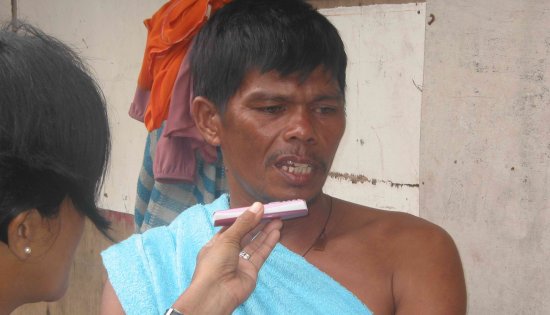
By JAZMIN BONIFACIO
April 24, 201
BRGY COSTA BRAVA, San
Jose, Tacloban City – “I fight ….and I am fighting for my three
young children…. that my children may not have to die so young…because
of hunger.”
Bonifacio `boning’ Mabag, a
45 yrs old tricycle driver and a father, who lost 5 of his young
children, and whose home was destroyed by typhoon Yolanda.
Mabag, was standing among
the twisted wreckage of his home as he was interviewed, reliving the
terror they felt while 30ft water and strong winds of 387 kph
obliterated their neighborhoods and Mabag described how he and his
wife and children took refuge.
“I and my wife were inside
our house and holding our children”, Mabag recalled.
“We thought we’d die ….GI
sheets and debris started slamming on us.” Mabag said.
Five of Mabag’s children
died, as they couldn’t get hold anymore the strong winds and current
of water as they try to hold on to the floating logs.
“I lost consciousness…. I
tried to look for my wife and children….but I know they are just here
somewhere,” fighting back tears, Mabag told Samar News.com.
His 38-year-old housewife,
Lorna, was then nine months pregnant when the typhoon occurred.
He exclaimed with joy as he
spotted his wife and his two children after two days of searching
along San Jose area, a coastal village in Tacloban City.
“I thought God just answered
one prayer to let me be OK but he answered both of them,” he said,
before being led away from the debris with his wife.
Mabag spoke of his
desperations as he tried to round up his family after the typhoon hit
and his relief when he realized they (his wife and 2 children) were
OK.
“Our hearts are broken for
the parents that are wondering about the state of other children that
have been hit, I know that there are families wondering where their
loved ones are”, Mabag said.
Family’s death is one of
many tragic stories to emerge from devastation of typhoon Yolanda. It
was one of many heartbreaking stories that emerged in the hours after
a deadly storm surge ripped through the city of Tacloban with
incredible tales of survival.
Rescuers were looking under
every single piece of debris for the missing.
More than five months now
after the onslaught of typhoon Yolanda in the city, Mabag is
determined to fight and he continues to hold on in faith that God is
going to take him through this.
He went back pedaling
tricycle (pedicab) for transporting goods and people as his means of
livelihood.
“I fight ….and I am fighting
for my three young children…. that my children may not have to die so
young…because of hunger.” Mabag said.
“So many times our problems
cause us to think that God has forgotten us. It is hard to understand
that the Source of our strength and our Provider in all things is
already with us. When a situation seems hopeless, it is difficult to
not grow weary and lose strength….. through the storm, we have the
peace of knowing that `all is well’ and we keep our eyes on our
Savior.” Mabag stressed.
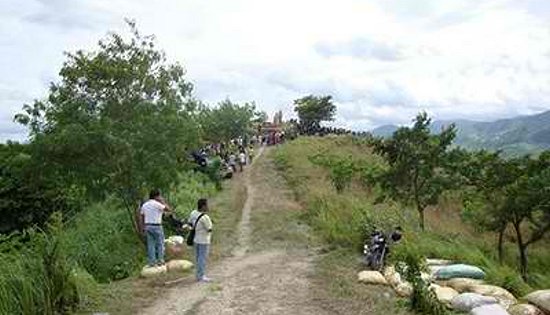
Site
of the Maguindanao massacre. (Photo by Mark Navales) |
Why Philippines is
ranked 3rd dangerous place for journalists, activists
By Asian Human Rights
Commission
April 17, 2014
HONG KONG – Recently, the
Committee to Protect Journalists (CPJ) published its report ranking
the country as 3rd “most deadly for journalists,” next to Iraq and
Somalia. In another report, the Global Witness ranked the country as
the 3rd “most dangerous" for environment and land defenders worldwide,
next to Brazil and Honduras, where indigenous people struggle for
control of their lands.
The comments and analysis
offered by the experts on the report, apart from their ranking of the
country, explains that after over ten years of these routine,
systematic and widespread attacks on human rights defenders in the
country, we have yet to understand the system that allows these
killings to happen.
Take for example, the
comment by Rupert Abbott, Amnesty International's Deputy Asia Pacific
Director, that “effective investigations and prosecution for crimes
involving human rights violations are rare.” From the AHRC work
documenting cases for a decade now, it is not an issue simply of
“rarity”, but rather that effective investigation and prosecutions are
prevented or obstructed. There is a distinction between rarity and
from being obstructed.
In the Philippines, those
who could have played an enormous role to ensure that the
investigation and prosecution of cases – like the complainants,
witnesses and families of the victims – have no protection. The
absence of protection certainly results in the poor investigation and
prosecution of cases. No police or prosecutors can ensure their
investigation and prosecution is effective if they have no
complainants, no witnesses and the families would not talk to them. No
complainants means there is no case.
The police and prosecutors
know this full well, but neither the police nor the prosecutors do
anything about it. It is the problem of “not doing anything” by the
State and its agents despite knowing the problem that prevents and
obstructs any forms of an effective and adequate investigation. It is
not a problem of a rarity of effective investigation. It is the
inaction and acts of omission by the police and prosecution that makes
effective investigations a rare phenomenon.
While it is partly correct
that the problem of unabated extrajudicial killings in the Philippines
is a “systemic problem in the country's criminal justice system”;
however, our question is: is the country’s system of justice founded
and based on fundamental protection of the right to life? As we have
seen, for many years, western countries, notably European countries,
have invested so much in improving and developing the country’s
criminal justice institutions. The police are given training on
effective investigation by foreign experts; so are the public lawyers
and prosecutors on prosecuting.
Thus, if we rely on this
thesis that the problem is purely “systemic” then it would assume that
solutions could be improving the system, like training and building of
the capacity for investigation and prosecution. Of course, we are not
discounting the importance of training and capacity building; however,
has there been any credible assessment that these methods prevented
extrajudicial killings; or have they led to the arrest, detention and
punishment of the perpetrators? No.
Not even those perpetrators
from within the police and the military, the likes of retired military
General Jovito Palparan have been arrested. One of the core problems
in the Philippines is not the rarity of the effective investigation
and prosecution from happening; or, the problem can be address by
developing their capacity to investigate alone. The problem is that
the security forces involved in extrajudicial killings, enforced
disappearance and torture of human rights defenders could not be held
to account by the law. They are rewarded, promoted and go unpunished.
So, how can the police and
prosecutors carry out an effective investigation and prosecution
respectively if the perpetrators are rewarded?
This pattern is not
difficult to understand. In fact, within his own backyard, President
Benigno Aquino III, in Hacienda Luisita, where seven farmers who were
demanding the rightful distribution of their land were killed by the
security forces on November 2004. None of those who killed the
protestors were punished. In fact, six or seven more activists and the
witness to the massacre were subsequently killed.
Also, the possibility of
putting perpetrators in jail, like the “two suspects have been jailed”
as mentioned in the Global Witness report also depends on who the
perpetrators are, who are the victims and who they are associated
with. There is deeply held bias and prejudice. The possibility of
punishment for the perpetrators is often measured on this. Some could
get some protection and relief; others do not have any at all.
In the experience of the
AHRC, there is a pattern of unequal application of the law in
arresting, prosecuting and detaining perpetrators to the murders of
journalists and human rights and political activists. Only those
persons whom the security forces and the government would consider as
‘not a threat to the internal security and its interest’ are likely to
get some form of protection and relief.
For example, protective
security was provided to Arthur Sapanghari, a broadcast journalist;
and his family, as they were facing threats for reporting corruption,
illegal logging and human trafficking in Bukidnon, Mindanao.
Obviously, Arthur was provided security because he himself is
involved, in the words of the police, “actively participates in the
peace and order campaigns in Valencia City.”
But how about those victims
and those families who protest against the police? In cases where the
policemen are themselves the perpetrators of extrajudicial killings?
Do they provide protection to the complainants, witnesses and
families? No.
The absence of protection is
clearly demonstrated in the case of Myrna Reblando and her family.
Myrna, widow of one of the victims of the Maguindanao massacre, has
pursued prosecution against the local politicians, the police,
soldiers and paramilitary forces responsible. In her case, she had to
leave the Philippines because neither the police nor the prosecution
could offer her adequate protection.
Her experience is similar to
the case of Florence “Dom-an” Macagne, widow of Jose “Pepe” Manegdeg, a
social activist who was killed by a soldier in November 2005. Despite
her own and her family’s repeated appeals: from the police and
prosecution to adequately investigate her husband’s case, and to
provide protection to the key witnesses who had identified the soldier
as the perpetrator, they did nothing. The court had to dismiss the
case because the witnesses withdrew due to insecurity. The victims’
family has to go in hiding due to insecurity.
The problem in the
Philippines is deep and one that is yet to be understood both by the
victims, their families, and those who could play a role to support
them. Without adequately understanding the problems, the rituals of
ranking, may help draw attention to them, but could not move and
provoke new ideas that could help in resolving the problem.
◄◄home
I
next►►